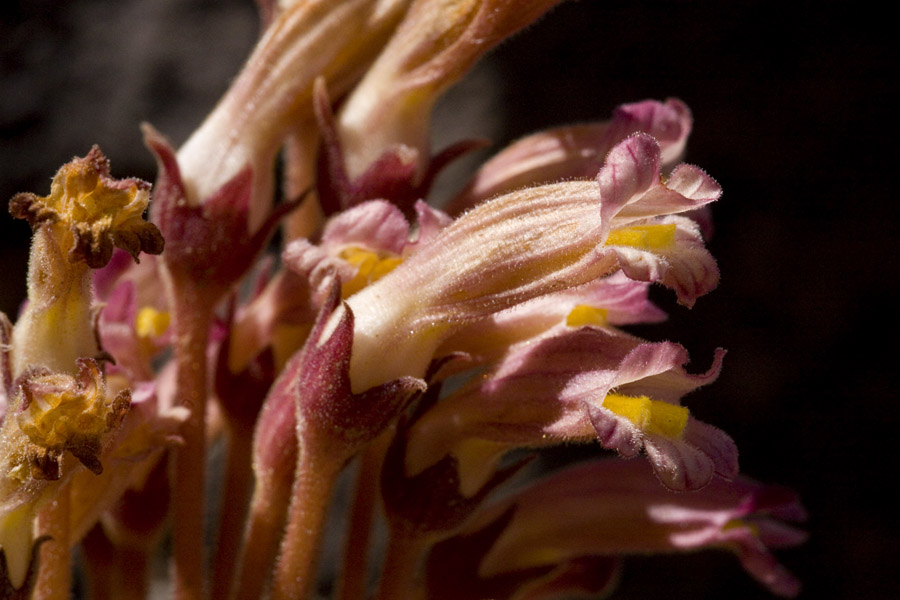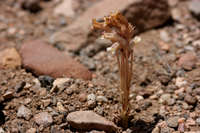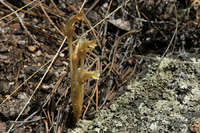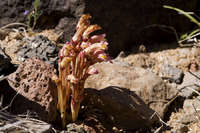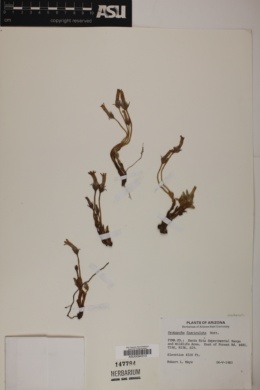|
Family: Orobanchaceae
clustered broomrape
[ Anoplanthus fasciculatus (Nutt.) Walp., moreOrobanche fasciculata Nutt., Orobanche fasciculata var. franciscana Achey, Orobanche fasciculata var. lutea (Parry) Achey, Orobanche fasciculata var. subulata Goodman, Orobanche fasciculata var. typica Achey, Thalesia fasciculata (Nutt.) Britt., Thalesia lutea (Parry) Rydb.] |
Parasitic herb 10 - 20 cm tall Stem: elongate, 5 - 15 cm long. Leaves: tiny, scale-like, egg-shaped with a pointed tip, hairy. Flowers: borne solitary on the end of a stalk, the two to ten stalks per plant each 2 - 15 cm long and arising from about the same point on the stem. The sepals are fused into a tube with triangular lobes no longer than the tube, and the purple petals are 1.5 - 3 cm long, tubular, and two-lipped. Fruit: a capsule. Similar species: Conopholis americana and Epifagus virginiana are easy to distinguish because they each have many flowers per plant. Orobanche uniflora differs by having hairless scale leaves, one to three flowers per plant in white, cream, lilac, or violet, and lance to awl-shaped calyx lobes that are longer than the calyx tube. Flowering: early to mid June Habitat and ecology: This species is rare in the Chicago Region but is parasitic on Artemisia caudata, beach wormwood, roots near Lake Michigan. Occurence in the Chicago region: native Etymology: Orobanche was the Greek name for a parasitic plant that grew on vetch. The word comes from the Greek words, orobos, the name for a vetch, and anchone, meaning "to choke or strangle,"referring to the plant's parasitic habit. Fasciculata means "clustered together in bundles." Author: The Morton Arboretum Parasitic on many spp., but especially on Artemisia; proper stem 5-15 cm; scale-lvs ovate, pubescent, all or at least the upper acuminate; pedicels 4-10, 2-15 cm, not much if at all longer than the stem, forming a loose, flat-topped corymb much surpassing the stem; bractlets none; cor 1.5-3 cm; cal-lobes about equaling the tube; 2n=24. Dry soil, prairies, and plains, in our range especially on sand-dunes; Mich. and nw. Ind. to B.C., Calif., and n. Mex. June. (Thalesia f.; Anoplanthus f.)
Gleason, Henry A. & Cronquist, Arthur J. 1991. Manual of vascular plants of northeastern United States and adjacent Canada. lxxv + 910 pp.
©The New York Botanical Garden. All rights reserved. Used by permission. Jepson 1993 Duration: Annual Nativity: Native Lifeform: Forb/Herb General: Parasitic annual forb, stem yellowish or purplish, 1 or clustered, 5-20 cm, branched or not, fleshy, glandular pubescent. Leaves: Reduced, 5-10 mm long, scalelike, alternate, no basal leaves. Flowers: Flat-topped raceme with 5-20 flowers per plant, more than 6 bracts, borne on 3-15 cm pedicels, shorter upwards; calyx lobes 3-7 mm, campanulate, deltate, generally acuminate; corolla 15-30 mm, curved, yellowish to purple-tinged, lobes rounded to narrowly acute; anthers generally hairy; stigma 2-lobed. Fruits: Ovoid capsule, 7-10 mm long, extremely small seeds. Ecology: Found in dry, generally bare areas from 4,000-8,000 ft (1219-2438 m); flowers April-July. Notes: Parasitic on shrubs generally, Artemisia and Eriogonum are a couple in our region. Host plant for the Variable Checkerspot Butterfly. Ethnobotany: Roots eaten as a lung medicine, used for wounds, when on sweet sage (Artemisia annua-) it is used for cancer, it is poisonous to livestock, used to wash sores, used for sores as a poultice, as a life medicine, for birth injuries, hemorrhoids, the entire plant can be eaten, even roasted and eaten like a baked potato, raw or boiled. Etymology: Orobanche is from Greek orobos, a kind of vetch, and anchone, choke or strangle because of the parasitic nature of the genus, while fasciculata means bundles, which describes the way the leaves attach to the stem in fascicles. Synonyms: Many, see Tropicos Editor: SBuckley, 2010 |

